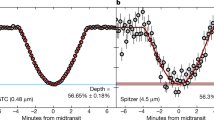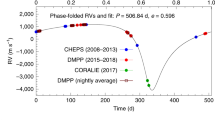Abstract
BAILES et al.1 have reported the discovery of a planet-mass object in a six-month orbit around the radio pulsar PS R1829–10. The parameters of the orbit, in particular its circularity, make it unlikely that this planet existed before the supernova explosion that presumably created the pulsar, and somehow survived1. Here we present two alternative explanations for the existence and orbital parameters of the claimed planet-mass object. In the first, the pulsar forms from the coalescence of two white dwarfs, and the planet condenses from a massive disk of material left behind. In the second, a neutron star collides with and cannibalizes the central star of a solar-type planetary system. The orbits of the inner planets are made elliptical by this collision, but then recircularized by drag forces due to the extended but short-lived envelope of the disrupted central star.
This is a preview of subscription content, access via your institution
Access options
Subscribe to this journal
Receive 51 print issues and online access
$199.00 per year
only $3.90 per issue
Buy this article
- Purchase on Springer Link
- Instant access to full article PDF
Prices may be subject to local taxes which are calculated during checkout
Similar content being viewed by others
References
Bailes, M., Lyne, A. G. & Shemar, S. L. Nature 352, 311–313 (1991).
Chevalier, R. A. Astrophys. J. 346, 847–859 (1989).
Benz, W., Bowers, R. L., Cameron, A. G. W. & Press, W. H. Astrophys. J. 348, 647–667 (1990).
Saio, H. & Nomoto, K. Astrophys. J. 150, L21–L23 (1985).
Iben, I. Jr & Tutukov, A. V. in Stellar Nucleosynthesis (eds Chiosi, C. & Renzini A.) 181–204 (1984).
Nomoto, K. & Iben, I. Jr Astrophys. J. 297, 531–537 (1985).
Fabian, A. C., Pringle, J. E. & Rees, M. J. Mon. Not. R. astr. Soc. 172, 15p–18p (1975).
Katz, J. I. Nature 253, 698–699 (1975).
Djorgovski, S. Astrophys. J. 317, L13–L14 (1987).
Spitzer, L. in Dynamics of Star Clusters (eds Goodman, J. & Hut, P.) 109–136 (Reidel, Dordrecht, 1985).
Ruffert, M. & Müller, E. Astr. Astrophys. 238, 116–133 (1990).
Thome, K. & Żytkow, A. N. Astrophys. J. 199, L19–L24 (1975).
Krolik, J. Astrophys. J. 282, 452–465 (1985).
Author information
Authors and Affiliations
Rights and permissions
About this article
Cite this article
Podsiadlowski, P., Pringle, J. & Rees, M. The origin of the planet orbiting PSR1829 – 10. Nature 352, 783–784 (1991). https://doi.org/10.1038/352783a0
Received:
Accepted:
Issue Date:
DOI: https://doi.org/10.1038/352783a0
This article is cited by
-
Using single millisecond pulsar for terrestrial position determination
Astrophysics and Space Science (2019)
-
Planets around pulsars: A review
Astrophysics and Space Science (1994)
Comments
By submitting a comment you agree to abide by our Terms and Community Guidelines. If you find something abusive or that does not comply with our terms or guidelines please flag it as inappropriate.



